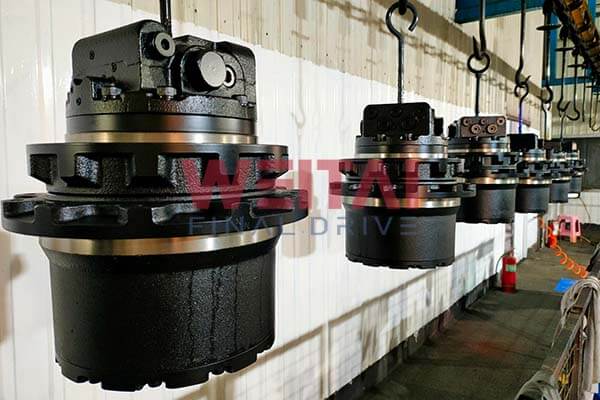Final drive motors are essential components in heavy machinery, responsible for delivering power and torque to the tracks or wheels. They allow your excavator, bulldozer, or skid steer to move smoothly across challenging terrains. Like any mechanical part, final drive motors wear out over time, and knowing the warning signs of failure can save you costly repairs and downtime.
In this post, we’ll cover the five most common signs that your final drive motor may need to be replaced.

________________________________________
1. Unusual Noises During Operation
One of the first and most obvious indicators of a failing final drive motor is strange noises. If you hear grinding, clunking, or whining sounds coming from the motor or tracks, this could signal internal issues like worn gears, damaged bearings, or a lack of lubrication. Noise is typically an early warning sign, and addressing it sooner rather than later can prevent more severe damage.
What to Do:
• Inspect the motor for debris or dirt buildup.
• Check the oil level and quality.
• If the noise persists, contact a professional technician to assess the internal components.
________________________________________
2. Leaking Hydraulic Fluid
Hydraulic fluid is the lifeblood of your final drive motor. If you notice oil leaks near the motor housing or under the machine, it’s a sign that the seals might be worn or damaged. Over time, seals can degrade due to heat, pressure, or contaminants in the system. Ignoring leaks can lead to insufficient lubrication and overheating, ultimately causing the motor to fail.
What to Do:
• Regularly inspect your final drive motor for oil leaks.
• Replace damaged seals as soon as possible.
• Monitor your hydraulic fluid levels to ensure proper lubrication.
________________________________________
3. Overheating
Final drive motors can overheat due to a variety of reasons, including low oil levels, internal friction, or clogged hydraulic filters. Excessive heat can damage internal components, such as bearings and seals, leading to more significant issues down the road. If your motor is running hotter than normal or if you notice a burning smell, it’s a sign that immediate action is needed.
What to Do:
• Check the hydraulic fluid level and quality.
• Inspect the filters and cooling systems to ensure proper flow.
• If the problem persists, a full diagnostic may be needed to identify internal issues.
________________________________________
4. Loss of Power or Slow Movement
A noticeable decrease in power or speed when operating your machine could indicate that your final drive motor is struggling to deliver adequate torque. This is often a sign of internal wear, low hydraulic pressure, or a failing gear set. If your machine seems sluggish or struggles to move uphill or across rough terrain, it’s essential to investigate the cause.
What to Do:
• Check for external obstructions, such as debris in the tracks or wheels.
• Inspect the hydraulic pressure system to ensure proper operation.
• If the problem isn’t external, it’s likely time for a motor replacement.
________________________________________
5. Jerky or Unstable Movements
Smooth operation is key to the performance of any heavy machinery. If you experience jerky or erratic movements, it’s likely that the final drive motor is experiencing internal mechanical issues. Damaged gears, worn-out bearings, or inconsistent hydraulic pressure can all cause instability, leading to dangerous operating conditions and further equipment damage.
What to Do:
• Inspect the hydraulic system for clogs or pressure inconsistencies.
• Check the tracks or wheels for proper alignment and tension.
• If instability continues, it’s best to replace the motor to avoid accidents or further breakdowns.
________________________________________
Conclusion: Don’t Ignore the Warning Signs
Final drive motors are critical to the performance and safety of your heavy equipment. Ignoring the early signs of failure can lead to costly downtime, significant repairs, and even equipment damage. Regular inspections, routine maintenance, and immediate action when you notice any of the above issues can help extend the life of your final drive motor and ensure smooth operation.
When in doubt, consult with a professional technician who can diagnose the issue and recommend whether repair or replacement is the best course of action. By staying proactive, you’ll avoid unexpected breakdowns and keep your machine running at peak performance.
Post time: Sep-04-2024
